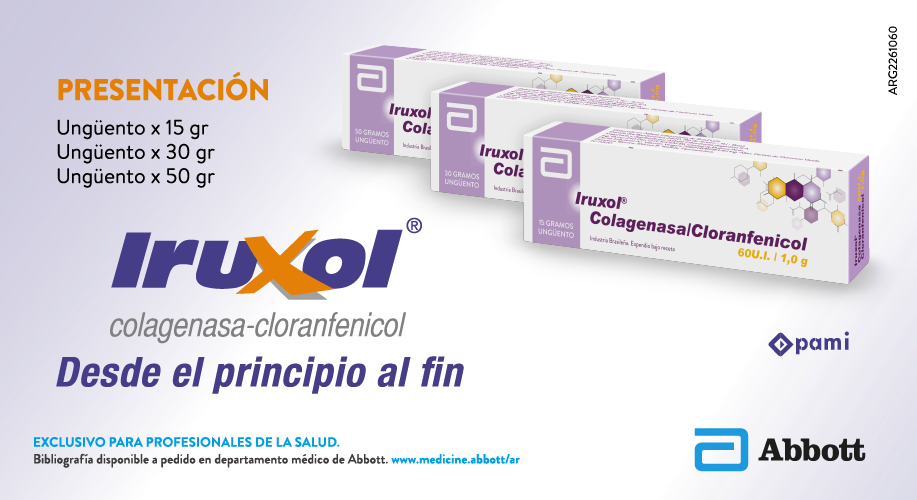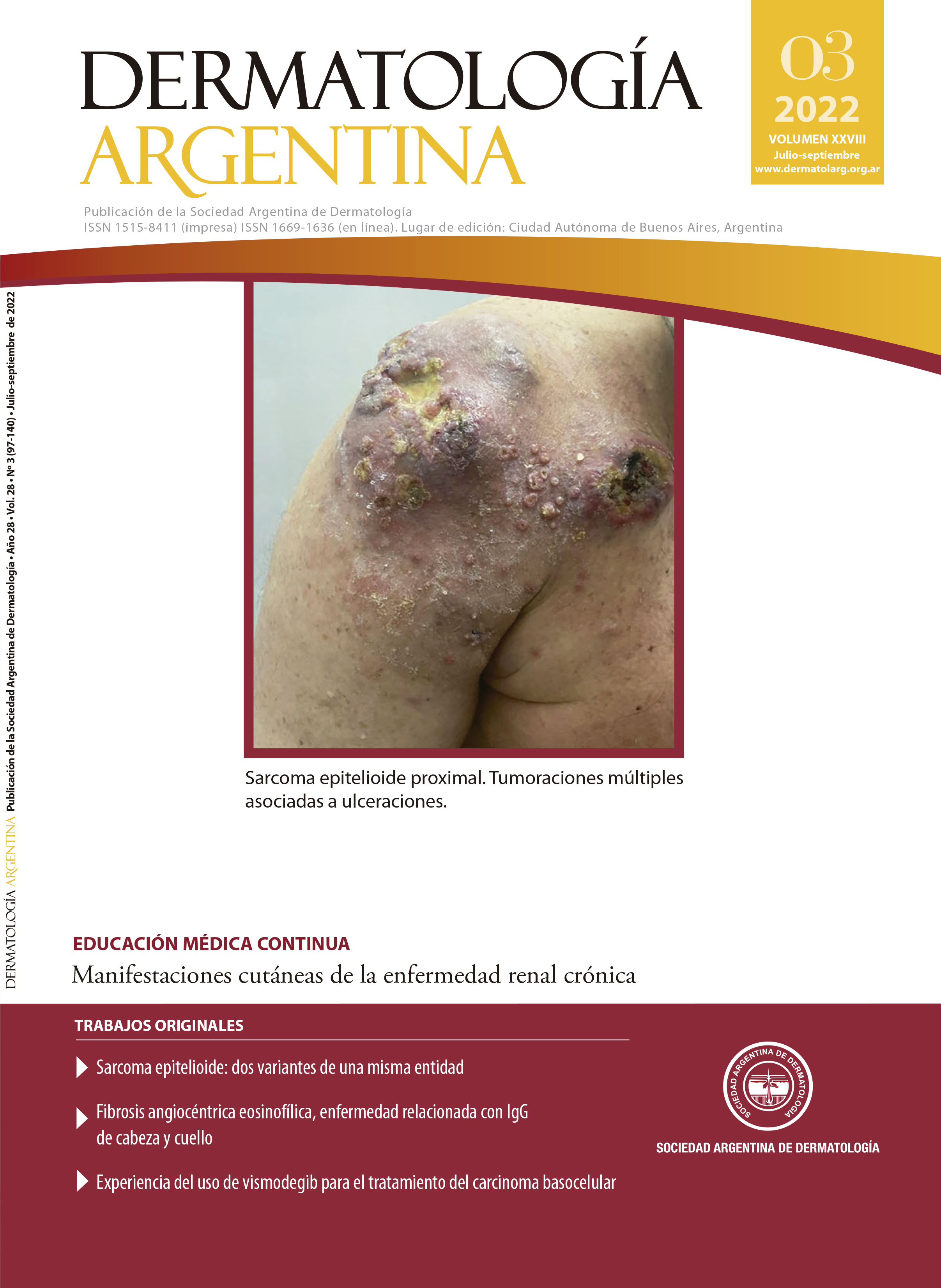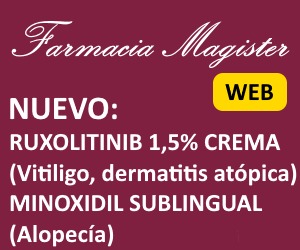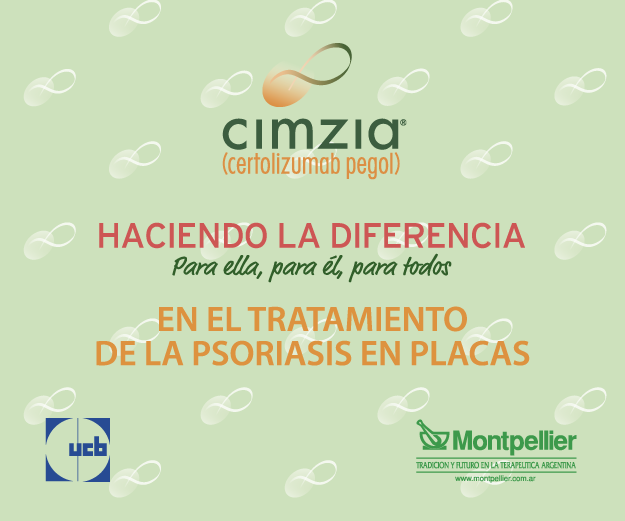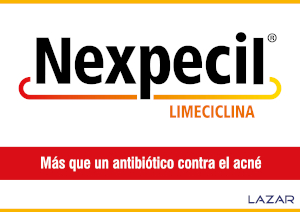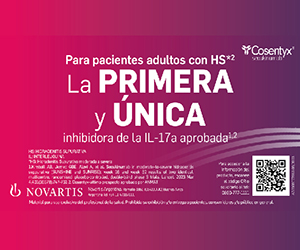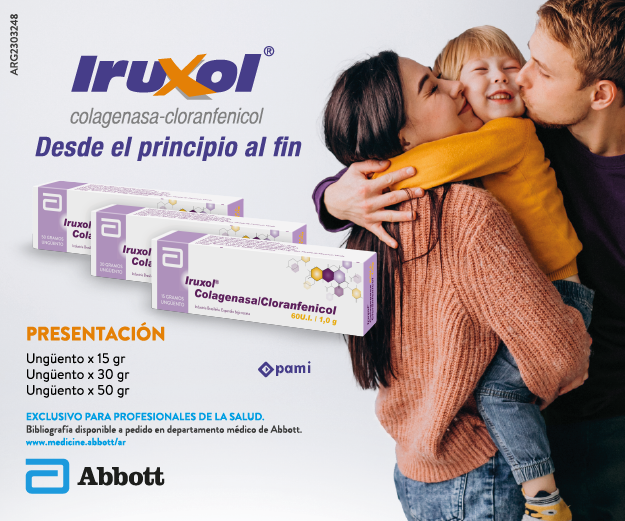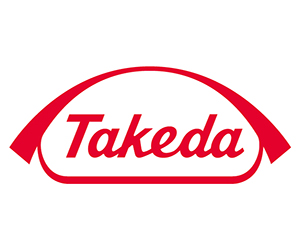Experience with the use of vismodegib for the treatment of basal cell carcinoma
Keywords:
basal cell carcinoma, non-melanoma skin cancer, keratinocyte tumors, vismodegib, sonic hedgehog inhibitorsAbstract
Treatment of locally invasive, metastatic, or inoperable basal cell carcinomas represents a challenge. The therapeutic options are limited and their choice depends on multiple factors. In 2012, the FDA demonstrated vismodegib, a systemic inhibitor of the hedgehog pathway, especially indicated for these patients. We present in this following series 9 cases treated with vismodegib, with the intention of sharing our experience. We describe, in each patient, the clinicopathological characteristics of the tumor, the duration of the treatment, its evolution and the adverse effects.
References
I. Marini M, Cabo H, Jaimovich L, Cabrera H, et ál. Consenso sobre Carcinoma Basocelular y Carcinoma Espinocelular. SAD [en línea]. Disponible en: https://sad.org.ar/wp-content/uploads/2019/10/basoespino.pdf.
II. González VM, Busso SP, Leitner R, Casas G, et ál. Estudio epidemiológico del carcinoma basocelular en un hospital de la comunidad. Dermatol Argent. 2009;15:37-43.
III. Marini MA, Marini MG, Minaudo C, López Andina P, et ál. Carcinoma basocelular. Ciudad Autónoma de Buenos Aires: Ediciones Científica Sur; 2019.
IV. Zito PM, Nassereddin A, Scharf R. Vismodegib. En: StatPearls [Internet]. Treasure Island (FL): StatPearls Publishing; 2022. Disponible en: https://www.ncbi.nlm.nih.gov/books/NBK513360/.
V. Dika E, Scarfi F, Ferracin M, Broseghini E, et ál. Basal cell carcinoma: a comprehensive review. Int J Mol Sci. 2020;21:5572.
VI. Gutzmer R, Solomon JA. Hedgehog pathway inhibition for the treatment of basal cell carcinoma. Target Oncol. 2019;14:253-267.
VII. Carballo GB, Honorato JR, de Lopes GPF, Spohr TCLSE. A highlight on Sonic hedgehog pathway. Cell Commun Signal. 2018;16:11.
VIII. Pellegrini C, Maturo MG, Di Nardo L, Ciciarelli V, et ál. Understanding the molecular genetics of basal cell carcinoma. Int J Mol Sci. 2017;18:2485.
IX. Spiker AM, Troxell T, Ramsey ML. Gorlin syndrome. En: StatPearls [Internet]. Treasure Island (FL): StatPearls Publishing; 2022. Disponible en: https:/www.ncbi.nlm.nih.gov/books/NBK430921/.
X. Palacios-Álvarez I, González-Sarmiento R, Fernández-López E. Gorlin syndrome. Actas Dermosifiliogr. 2018;109:207-217.
XI. Gupta N, Ruiz ES. Current Perspectives in the treatment of locally advanced basal cell carcinoma. Drug Des Devel Ther. 2022 14;16:183-190.
XII. Kim DP, Kus KJB, Ruiz E. Basal cell carcinoma review. Hematol Oncol Clin North Am. 2019;33:13-24.
XIII. Ching JA, Curtis HL, Braue JA, Kudchadkar RR, et ál. The impact of neoadjuvant hedgehog inhibitor therapy on the surgical treatment of extensive basal cell carcioma. Ann Plast Surg. 2015;74:S193-197.
XIV. Migden MR, Chang ALS, Dirix L, Stratigos AJ, ét al. Emerging trends in the treatment of advanced basal cell carcinoma. Cancer Treat Rev. 2018;64:1-10.
XV. Jaal J, Putnik K. Induction cisplatin-based chemotherapy and following radiotherapy in locally advanced basal cell carcinoma of the skin. Acta Oncol. 2012;51:952-954.
XVI. National Comprehensive Cancer Network (NCCN). NCCN Clinical Practice Guidelines in Oncology. Basal Cell Skin Cancer. Version 2.2022. March 24,2022.
XVII. Sekulic A, Migden MR, Basset-Seguin N, Garbe C, et ál. Long-term safety and efficacy of vismodegib in patients with advanced basal cell carcinoma: final update of the pivotal ERIVANCE BCC study. BMC Cancer. 2017;17:332.
XVIII. Xie P, Lefrançois P. Efficacy, safety, and comparison of sonic hedgehog inhibitors in basal cell carcinomas: a systematic review and meta-analysis. J Am Acad Dermatol. 2018;79:1089-1100.
XIX. Cozzani R, Del Aguila R, Carrizo M, Sánchez S, ét al. Efficacy and safety profile of vismodegib in a real-world setting cohort of patients with advanced basal cell carcinoma in Argentina. Int J Dermatol. 2020;59:627-632.
XX. Kim DJ, Kim J, Spaunhurst K, Montoya J, et ál. Open-label, exploratory phase II trial of oral itraconazole for the treatment of basal cell carcinoma. J Clin Oncol. 2014;32:745-751.
Downloads
Published
Issue
Section
License
Copyright (c) 2022 on behalf of the authors. Reproduction rights: Argentine Society of Dermatology.

This work is licensed under a Creative Commons Attribution-NonCommercial-NoDerivatives 4.0 International License.
El/los autor/es tranfieren todos los derechos de autor del manuscrito arriba mencionado a Dermatología Argentina en el caso de que el trabajo sea publicado. El/los autor/es declaran que el artículo es original, que no infringe ningún derecho de propiedad intelectual u otros derechos de terceros, que no se encuentra bajo consideración de otra revista y que no ha sido previamente publicado.
Le solicitamos haga click aquí para imprimir, firmar y enviar por correo postal la transferencia de los derechos de autor


